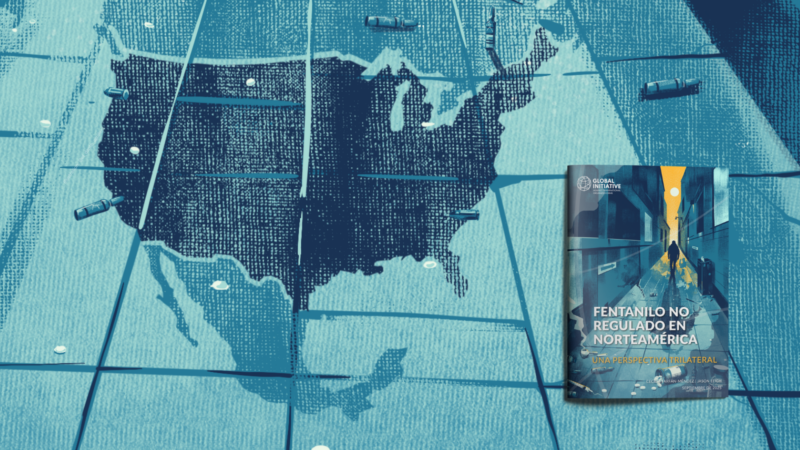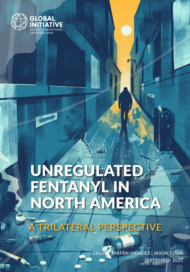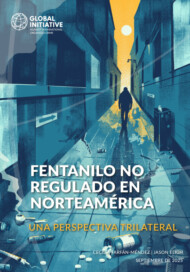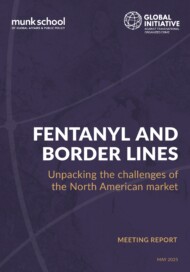More than 1.1 million people in the United States have died from opioid overdoses since 2000. In Canada, over 50,000 lives have been lost to opioid-related overdoses since 2016. Meanwhile, in Mexico, homicide—mostly committed with illegally trafficked firearms—is the leading cause of death among men aged 15 to 44. These overlapping crises reveal that the harms associated with synthetic opioids are not confined to one country but span all of North America.
This policy brief sheds light on how illicitly manufactured fentanyl (IMF) is produced and distributed within and across Mexico, the US, and Canada. The report reveals a complex and highly integrated system of production, tablet pressing, trafficking, and consumption. Far from being a product trafficked into North America, IMF is increasingly produced on its soil.
Key insights include the emergence of a new “golden triangle” of trafficking and violence between the Mexican states of Baja California, Sonora, and Sinaloa, where fentanyl production overlaps with high levels of firearm-related homicides. Fentanyl production in Mexico is closely linked to firearms trafficking from the United States, with Arizona emerging as a predominant source. In Canada, production largely serves the domestic market using chemical precursors imported directly and processed in clandestine labs. In the US, criminal actors engage in adulteration and tablet pressing—often making use of legal trade flows and customs loopholes to facilitate trafficking.
The paper also challenges common assumptions: 83.5% of those convicted of fentanyl trafficking in the US in 2024 were US citizens, and most trafficking across the Mexico–US border occurs through legal ports of entry, not between them.
Recommendations for all three countries focus on data transparency, coordinated public health responses, and transnational cooperation. The paper calls for more investment in evidence-based interventions and a shift away from unilateral or enforcement-only strategies.
Deaths in North America from overdoses and homicides linked to fentanyl are not inevitable. But addressing it requires governments to exchange know-how and coordinate action across borders, just as criminal networks do.
Click the image below to read more:
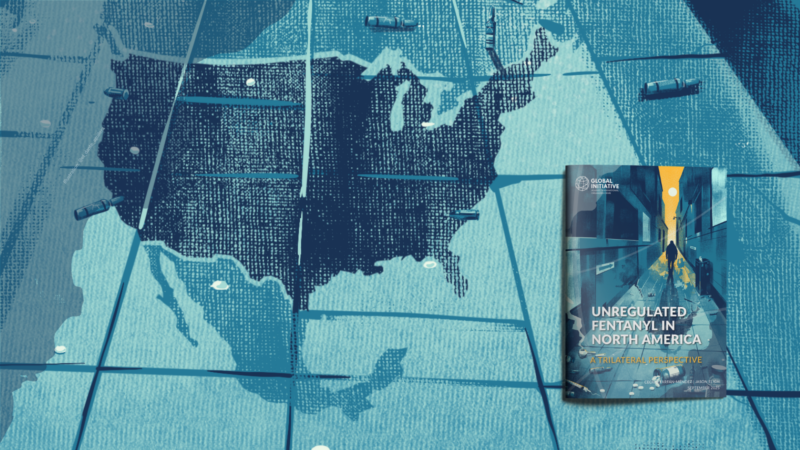
Fentanilo no regulado en Norteamérica
Una perspectiva trilateral
Más de 1,1 millones de personas en Estados Unidos han muerto por sobredosis de opioides desde el año 2000. En Canadá, se han perdido más de 50.000 vidas por sobredosis relacionadas con opioides desde 2016. Mientras tanto, en México, el homicidio —en su mayoría cometido con armas de fuego traficadas ilegalmente— es la principal causa de muerte entre hombres de 15 a 44 años. Estas crisis superpuestas revelan que los daños asociados con los opioides sintéticos no se limitan a un solo país, sino que se extienden por toda América del Norte.
Este policy brief analiza cómo el fentanilo fabricado ilícitamente (IMF, por sus siglas en inglés) se produce y distribuye dentro y entre México, Estados Unidos y Canadá. El informe revela un sistema complejo y altamente integrado de producción, prensado de tabletas, tráfico y consumo. Lejos de ser solo un producto traficado hacia América del Norte, el IMF se produce cada vez más en su propio territorio.
Entre los hallazgos clave se incluye la aparición de un nuevo “triángulo dorado” de tráfico y violencia entre los estados mexicanos de Baja California, Sonora y Sinaloa, donde la producción de fentanilo se superpone con altos niveles de homicidios relacionados con armas de fuego. La producción de fentanilo en México está estrechamente vinculada al tráfico de armas desde Estados Unidos, siendo Arizona una fuente predominante. En Canadá, la producción atiende en gran medida al mercado interno mediante precursores químicos importados directamente y procesados en laboratorios clandestinos. En Estados Unidos, actores criminales participan en la adulteración y prensado de tabletas, a menudo aprovechando flujos comerciales legales y vacíos aduaneros para facilitar el tráfico.
El documento también cuestiona suposiciones comunes: el 83,5% de las personas condenadas por tráfico de fentanilo en EE. UU. en 2024 eran ciudadanos estadounidenses, y la mayor parte del tráfico a través de la frontera México–EE. UU. ocurre en puertos de entrada legales, no entre ellos.
Las recomendaciones para los tres países se centran en la transparencia de datos, respuestas coordinadas de salud pública y cooperación transnacional. El documento pide más inversión en intervenciones basadas en evidencia y un cambio de estrategias unilaterales o únicamente represivas.
Las muertes en América del Norte por sobredosis y homicidios vinculados al fentanilo no son inevitables. Pero enfrentarlas requiere que los gobiernos intercambien conocimientos y coordinen acciones a través de fronteras, tal como lo hacen las redes criminales.
Haz clic en la imagen de abajo para leer más:
